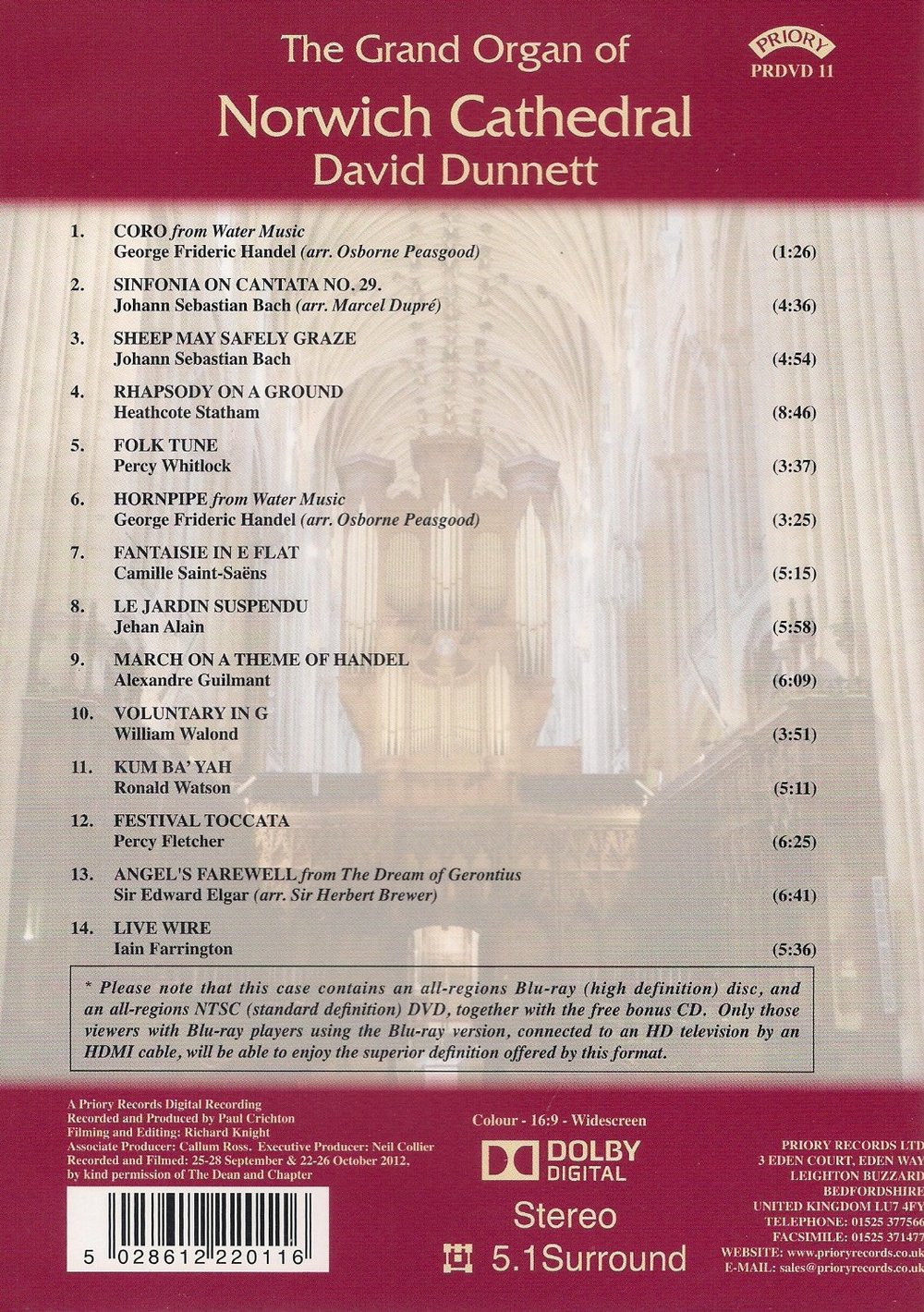

David Dunnett in 2012 plays the following selections on the grand organ of the Norwich Cathedral:
Handel "Coro" from Water Music (arr. Osborne Peasgood)
J. S. Bach "Sinfonia on Cantata No. 29" (arr. Marcel Dupré)
J. S. Bach "Sheep May Safely Graze"
Heathcote Statham "Rhapsody on a Ground"
Percy Whitlock "Folk Tune"
Handel "Hornpipe" from Water Music (arr. Osborne Peasgood)
Saint-Saëns"Fantaisie in E flat"
Jehan Alain "Le Jardin suspendu"
Alexandre Guilmant "March on a Theme of Handel"
William Walond "Voluntary in G"
Ronald Watson "Kum ba'yah"
Percy Fletcher"Festival Toccata"
Elgar "Angel's Farewell"from The Dream of Gerontius (arr. Sir Herbert Brewer)
Iain Farrington "Live Wire"
Priory specializes in church and organ music. This package has a Blu-ray, a DVD, and a CD! Recorded and produced by Paul Crichton; filmed and edited by Richard Knight; Associate Producer was Callum Ross; Executive Producer was Neil Collier. Released 2014, disc has 5.1 Dolby Digital surround sound. Grade: A
Serenity, communion with nature, and grandeur characterize most of the selections on this program played in the Cathedral of semi-rural Norwich, England:
If you haven't visited the Norwich Cathedral, it's hard from photos taken from the ground to understand how the church is laid out. Below is an aerial photo (not found on the subject title). The front door of the building is in the lower right. Then there is an enormously long nave leading to the altar. The steeple rises above the altar. Two semitransepts extend from the altar perpendicular to the nave. Behind the altar is the ambulatory. From high above, the church would appear to have the shape of the traditional Christian cross. The ambulatory (which you can't see from this view) is supported by flying buttresses:
Four views of David Dunnett, Chief Organist for the Cathedral, performing the program:
Even with the great flexibility of his mighty instrument, Dunnett finds himself stretching to finish these runs:
Videographer Richard Knight fills the disc with magnificent images. Here are three shots of the altar and an organ case behind it. Think of the power required to push the music down the entire length of the huge, narrow nave:
Another organ case in one of the transcepts:
I think this is the interior of the ambulatory:
The severity of the stone is offset by quaint and even comical fixtures in the roof:
As is customary in the Grand Organ series from Priory, Knight also gives us many shots from the town and countryside. This scene illustrates Bach's Sheep May Safely Graze on Track 3 of the disc:
A Peeping Tom?
Or perhaps he's guarding the Cathedral herb garden:
Or perhaps he arranges the flowers:
There has been a grand organ at Norwich for centuries. For much of that time, the organ and the choir made the only "real" or serious music that most people heard during their entire lives. The organ was many times damaged or destroyed by fire. The most spectacular of these calamities occurred when the Puritans tore the organ apart and used the pieces for a bonfire. Each rebuilding of the organ led to new improvements. Today everything played can be recorded. Then the organist can sit in the most-distant pew at the start of the nave and hear the organ replay the music exactly as the organist just performed it. What a tool for improving your act!
According to Dunnett, the Norwich instrument is a "romantic organ" augmented with additional baroque voices:
What's this below? Why, the organ has bells to play at Christmas!
Norwich has a puppet theater. Here one of the characters adds his piping to the organ's output:
And who is this below? Why it's a tiny owl that you can see in the picture above sitting to the right of the upper manual keyboard. Nobody knows why he's there, but neither can anyone remember a time when he wasn't on duty. So he's now a permanent part of the organ:
Returning to more serious matters, the Angel's Farewell by Elgaris played in memory of Edith Cavell, who died at age 49 during World War I:
And here's Edith's story:
In addition to the regular program, there are 3 separate bonus features in which Dunnett (1) makes comments (12 minutes) about all the pieces performed, (2) gives a detailed tour (25 minutes) of the organ's construction and capabilities, and (3) for seven minutes explains, with 4 screens running simultaneously, his techniques for playing the Angel's Farewell. And, as always, Priory provides a detailed booklet with more information about the pieces played and the specifications of the Norwich organ.
Anyone with an interest in the organ should find this a happy addition to the titles on his shelf, and I cheerfully give Priory another A grade for this fine disc.
OR

























